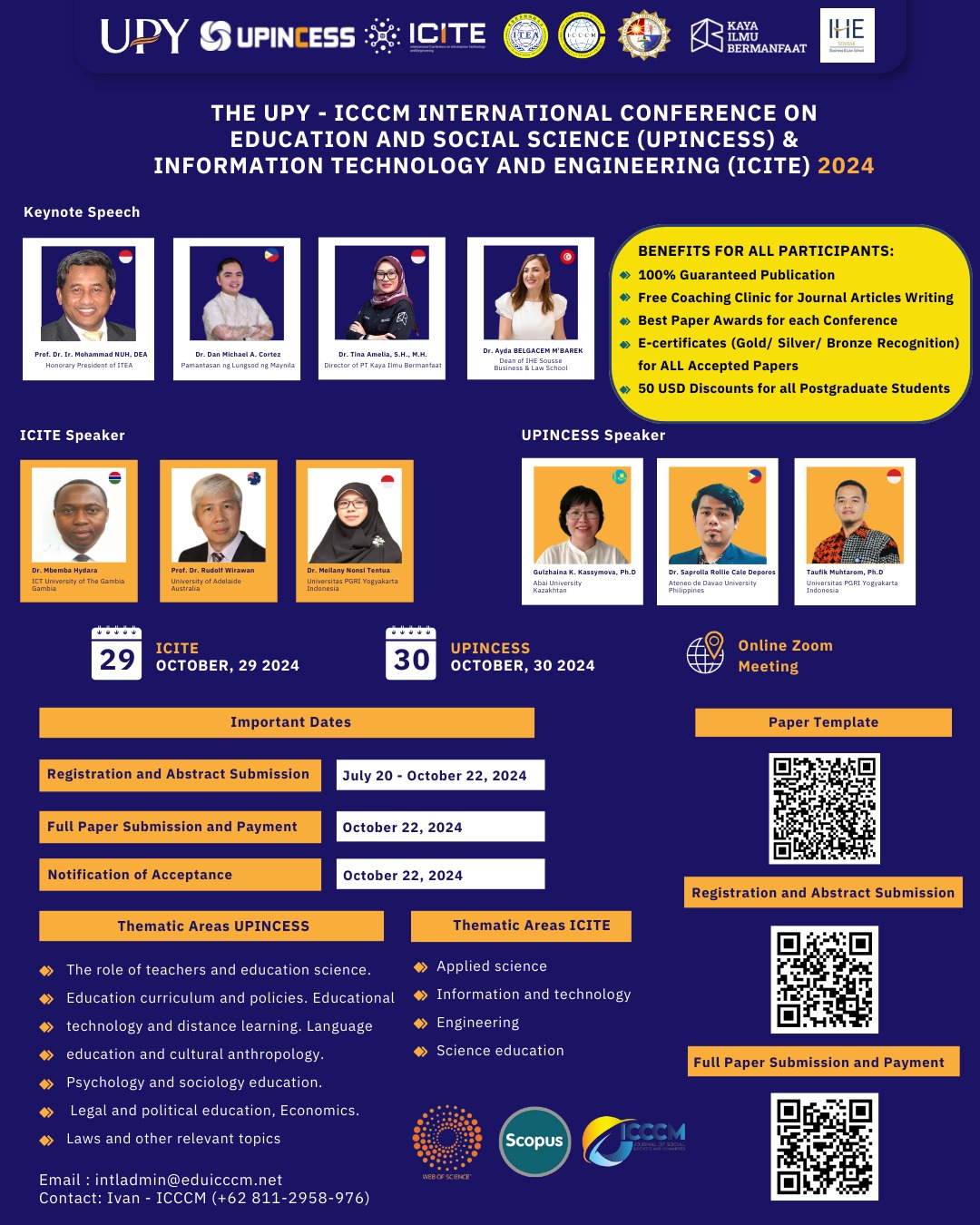The Sinergy of Law and Technological Development for Humankind: Cyber Crime
DOI:
https://doi.org/10.53797/icccmjssh.v3i3.4.2024Keywords:
Cyber-crime, technological development, cyber lawAbstract
This article aims to let us learn more about cyber-crime. The development of this information technology in turn changes the social order and behavior. In fact, it does not only end there, but also changes the reality of the economy, culture, politics and law. Therefore, behind the positive benefits, internet technology also has a small negative impact. Information technology is the mother of cyber-crimes. In other word, cyber-crime is nothing more than wrongful use of computer technology. This research is a normative legal research, so according to the type and nature of the research, the data sources used are secondary data consisting of primary legal materials and secondary legal materials consisting of books, scientific journals, scientific papers and articles that can provide an explanation of the material primary law. Cybercrime actually not only uses the sophistication of computer technology but also utilizes information technology computer in its operation. The development of information technology has also formed a new world society that is no longer hindered by territorial boundaries and has turned everything that is far away from being near what is imaginary into reality. But behind this progress, has also given birth to new unrest with the emergence of sophisticated crime in the form of cybercrime. The increasing number of cybercrime cases (especially in Indonesia) has attracted the attention of the government to immediately enact laws that can be used to trap criminals in cyberspace. The Indonesian government itself has incorporated the Cybercrime Law into the ITE Law Number 11 of 2008, and hopes that the ITE Law Number 11 of 2008 can overcome, reduce, and stop the perpetrators of crime in cyberspace.
Downloads
References
Anshari, M., Almunawar, M. N., & Masri, M. (Eds.). (2021). FinTech Development for Financial Inclusiveness. IGI Global.
Coccia, M. (2019). Why do nations produce science advances and new technology?. Technology in Society, 59, 101124. https://doi.org/10.1016/j.techsoc.2019.03.007
Ejiaku, S. A. (2014). Technology adoption: Issues and challenges in information technology adoption in emerging economies. Journal of International Technology and Information Management, 23(2), 59-68. https://doi.org/10.58729/1941-6679.1071
Habibi, M. R., & Liviani, I. (2020). Kejahatan Teknologi Informasi (Cyber Crime) dan Penanggulangannya dalam Sistem Hukum Indonesia. Al-Qanun: Jurnal Pemikiran Dan Pembaharuan Hukum Islam, 23(2), 400-426. ttps://doi.org/10.15642/alqanun.2020.23.2.400-426
Husak, D. (2005). Criminal law theory. The Blackwell Guide to the Philosophy of Law and Legal Theory, 107-121. https://doi.org/10.1002/9780470690116
Karagiannopoulos, V., Kirby, A., Ms, S. O. M., & Sugiura, L. (2021). Cybercrime awareness and victimisation in individuals over 60 years: A Portsmouth case study. Computer Law & Security Review, 43, 105615. https://doi.org/10.1016/j.clsr.2021.105615
Koto, I. (2021). Cyber crime according to the ITE law. International Journal Reglement & Society (IJRS), 2(2), 103-110. https://doi.org/10.55357/ijrs.v2i2.124.
Kumari, A., & Bhushan, S. (2021). Cybercrime: the high criminals and technology. UGC Care Journal, 44(1), 24-28.
Laksana, A. W. (2018). Cybercrime Comparison Under Criminal Law In Some Countries. Jurnal Pembaharuan Hukum, 5(2), 217-226.
Oates, B. (2001). Cyber crime: How technology makes it easy and what to do about it. Information systems management, 18(3), 92. https://doi.org/10.1201/1086/43298.9.6.20010102/30989.8
Raodia, R. (2019). Pengaruh Perkembangan Teknologi Terhadap Terjadinya Kejahatan Mayantara (Cybercrime). Jurisprudentie: Jurusan Ilmu Hukum Fakultas Syariah Dan Hukum, 6(2), 230-239. ttps://doi.org/10.24252/jurisprudentie.v6i2.11399
Sari, N. W. (2018). Kejahatan cyber dalam perkembangan teknologi informasi berbasis komputer. Jurnal Surya Kencana Dua: Dinamika Masalah Hukum Dan Keadilan, 5(2), 577-593. Scribbr. https://core.ac.uk/reader/337609060
Sumarwani, S. (2014). Tinjauan Yuridis Pemidanaan Cybercrime Dalam Perpektif Hukum Pidana Positif. Jurnal Pembaharuan Hukum, 1(3), 287-296. Scribbr. https://jurnal.unissula.ac.id/index.php/PH/article/view/1489
Umanailo, M. C. B., Yulisvestra, M., Oki, K. K., Mulyasari, W., & Ridwan, R. (2019a). The Thought of Emile Durkheim in the Contestation of Development in Indonesia. Int. J. Sci. Technol. Res, 8(8), 1881-1885.
Umanailo, M., Fachruddin, I., Mayasari, D., Kurniawan, R., Agustin, D. N., Ganefwati, R., ... & Hallatu, T. G. R. (2019b). Cybercrime case as impact development of communication technology that troubling society. International Journal Of Scientific & Technology Research, 8(9), 1224-1228.
Wahyudi, D. (2013). Perlindungan Hukum Terhadap Korban Kejahatan Cyber Crime Di Indonesia. Jurnal Ilmu Hukum Jambi, 4(1), 43295.
Widijowati, D. (2022). Legal Complexity in Dealing with Cyber Crime in Indonesia. Research Horizon, 2(6), 597-606. https://doi.org/10.54518/rh.2.6.2022.597-606
Zainuddin, Z., & Ramadhani, R. (2021). The Legal Force Of Electronic Signatures In Online Mortgage Registration. Jurnal Penelitian Hukum De Jure, 21(2), 243-252.
Downloads
Published
How to Cite
Issue
Section
License
Copyright (c) 2024 Haryono, Suparnyo

This work is licensed under a Creative Commons Attribution-NonCommercial-ShareAlike 4.0 International License.




